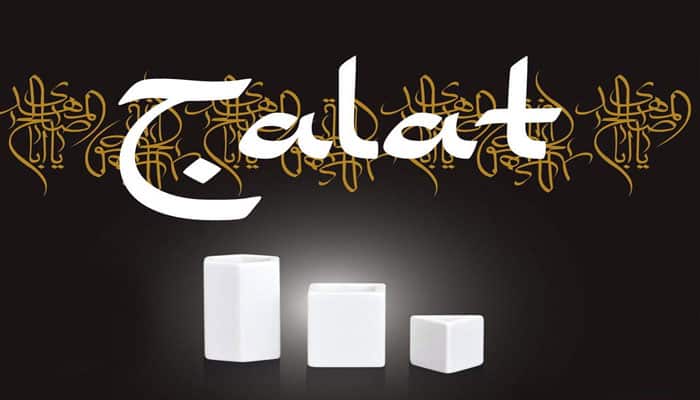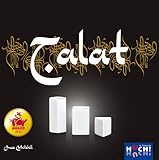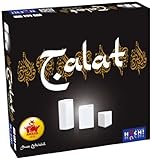

Components
- 3 game boards,
- 27 towers
- Instructions
Overview
Each player receives 9 towers of his own color. The game boards are arranged into a triangle so that each player can comfortably reach the starting lines of his two-game boards.
The oldest player begins. When playing more than one game, the winner of the last game always begins the new one.
Note: If you play Talat as a two-player game, the same basic rules apply, along with the additional rules.
1. Setup
Players take turns placing one of their 9 towers on the starting spaces of their own starting lines until all towers have been placed.
Once all the towers have been placed, each player should have one free space left on one of his starting lines.
Note: Each space may be occupied by one tower only. You have to decide which tower you want to place onto which game board.
Once a tower has been placed on the board, it may not be moved again during the setup phase!
2. Moving and Capturing
Moving
On his turn, a player may move any one of his own towers one space forward, straight ahead or diagonally, to an unoccupied space.

Note: You must move on your turn; you are not allowed to pass. You are not allowed to move a tower backwards or jump over another tower.
Since you may move only one of your own towers per turn, you may play on only one game board per turn. You do not have to move all your towers from your starting line.
If you move a tower onto an opposing player's starting line, the tower remains in that space unless captured or capturing sideways (see below).

Capturing
You can capture an opposing tower if it is standing either directly or diagonally in front of one of your towers, or is on either side of it, depending on their sizes and shapes, as explained below.
-
A tower can capture any tower that is one level smaller. Therefore, the largest towers can capture any medium sized tower, but not the smallest towers. A medium-sized tower can capture any small tower.
-
If two towers are the same height, the tower with more sides can capture the tower with fewer sides. Therefore, towers with six sides can capture towers with four sides or three sides , and four-sided towers can capture three-sided ones.
-
Thus, a tower cannot capture another tower of the same height with the same number of sides.
-
The David-and-Goliath rule: The small three-sided tower can capture the largest six-sided tower.
When you capture a tower, place the captured tower in front of you. Your tower remains on the space that had been occupied by the captured tower.

Note:
You do not have to capture an opponent's tower. You are not allowed to capture one of your own towers. A tower on a player's starting line can still capture or be captured if it is next to an opponent's tower.
End of the Game
When no more captures are possible on a board, the board is "frozen " and players are no longer allowed to move their towers on that board.
That means, of course, that towers you had hoped to move into your opponent's starting spaces to score may be stopped short of their goal.
When two of the three boards are frozen, the game is over.

The board is frozen.
Towers 1 and 2 are too far apart for tower 1 to capture tower 2, even if the two move toward each other.

The board is frozen. Tower 2 can no longer capture tower 3, since the tower is too far away.
Tower 3 and tower 4 cannot capture tower 1, since the tower is two levels smaller.

Tower 1 could theoretically still be captured by tower 2 (David-and- Goliath rule). In order for that to happen, tower 3 would have to move to the space shown by the blue arrow.
If tower 1 moves forward to the X, the board is still not frozen, since 1 could theoretically move forward again along the diagonal to the space next to 2.
Since the board is not frozen, tower 1 can, instead, move straight forward (not diagonally) into grey's starting area to score. Then the board would be frozen.
Note: If it is still theoretically possible for a tower to be captured on a board, play can continue on that board, even if it means that towers are only moving and not capturing.
Scoring
Every captured tower, irrespective of its shape or size, is worth 5 points. Every tower that ends up on an opponent's starting line is worth an additional 3 points.
The player with the most points wins.
In the event of a tie, towers are compared. Whoever has captured a tower that ranks higher than those of the other tying player(s), wins the tie. If players are still tied, everybody's a winner!
Continue Reading


